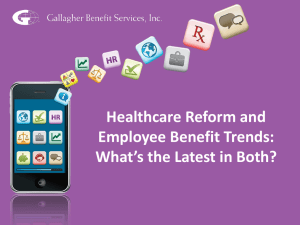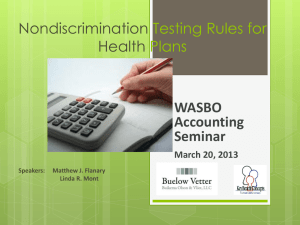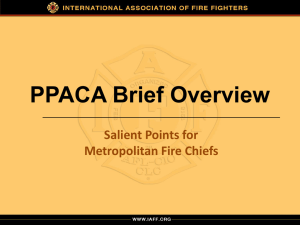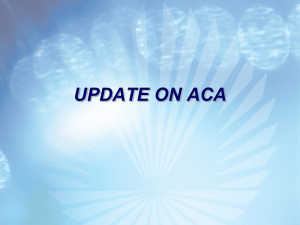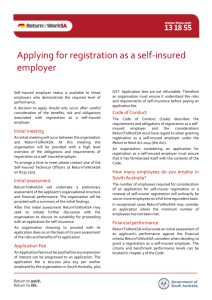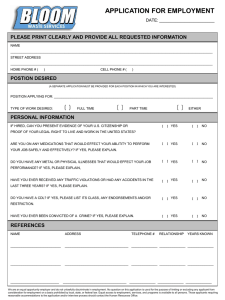Exemptions
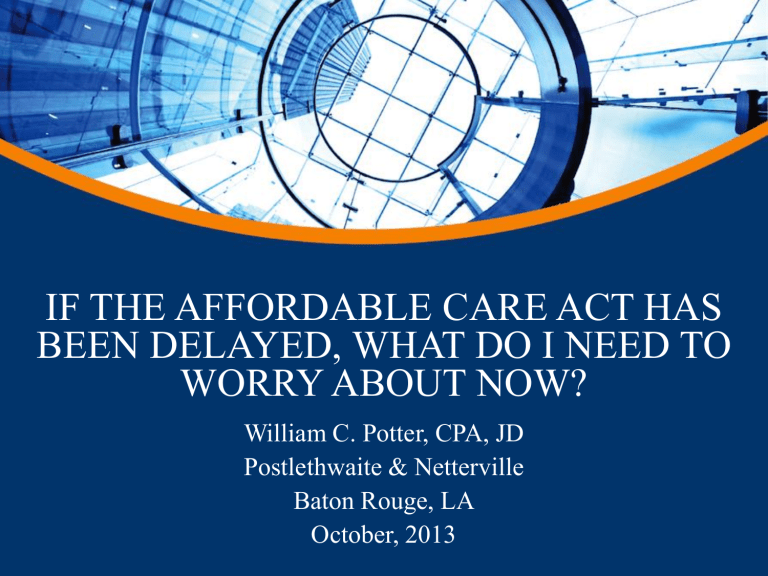
IF THE AFFORDABLE CARE ACT HAS
BEEN DELAYED, WHAT DO I NEED TO
WORRY ABOUT NOW?
William C. Potter, CPA, JD
Postlethwaite & Netterville
Baton Rouge, LA
October, 2013
What’s Been Deleted or Delayed
•
1099 reporting - deleted
•
Free choice vouchers – deleted
•
CLASS Act - deleted
•
Automatic enrollment - delayed
•
Nondiscrimination testing - delayed
•
Employer mandate and reporting - delayed
•
Income verification – delayed
•
SHOP – delayed
•
MSPP - delayed
Delay of the Employer Mandate
•
All other provisions continue on:
–
Individual mandate – expected to leave about 1 million people scrambling to get insurance
–
Monetary caps on annual out–of–pocket maximums
–
Elimination of lifetime and annual limits
–
New wellness plan rules
–
Notice of exchange options
Grandfathered Plan
•
Plan in existence on March 23, 2010 and employer has maintained the status quo
•
Only about 27% are GF plans
• Don’t have to:
–
Offer free preventive services
–
Satisfy nondiscrimination
–
Enhance review and appeals process
–
Meet cost sharing restrictions
Additional Medicare Tax
•
Starts January 1, 2013
•
Wages - an additional 0.9% employee only
•
Threshold amounts - $250,000 MFJ,
$125,000 MFS, $200,000 all others
•
Net Investment Income – an additional
3.8%
•
Same thresholds and applies to trusts
•
Statute – a couple of paragraphs
•
Proposed regs – 100+ pages
•
Planning for trusts and estates
•
S Corps
New Fees/Taxes
•
Tanning bed tax
•
DME tax
•
Prescription drug fee – other than orphan drugs
•
PCORI fee
•
Transitional reinsurance fee
•
Health insurance tax
New Regulations
•
You pay a fine if your spouse or dependent is not covered
•
Minimum essential coverage
–
Pretty much any group health plan meets this
– Watch for proliferation of “skinny plans”
•
Small fines will incentivize more people to go without coverage
–
Particularly since no issue with pre-existing condition
YEAR
2014
2015
2016
Individual Mandate
Applicable Dollar Amount
Penalty is $95 per adult and $47.50 per child (up to $285 for a family) or 1.0% of family income, whichever is greater
Penalty is $325 per adult and $162 per child (up to $975 for a family) or 2.0% of family income, whichever is greater.
Penalty is $695 per adult and $347.50 per child (up to $2,085 for a family) or
2.5% of family income, whichever is greater.
Individual Mandate
•
Exemptions:
• coverage is unaffordable (exceeds 9.5% of household income);
•
Not required to file an income tax return ;
•
Native Americans - eligible for IHS or participates in a healthcare sharing ministry;
• short lapse in coverage = less than three months;
• suffered a hardship – 11 listed events, such as, eviction and bankruptcy;
• dependent;
• Qualify for the foreign earned income exclusion
• People who have no plan options in their states health insurance exchange
• Religious conscience – member of a recognized religious sect
(Amish) or meets the requirements of Section 1402(g)(1) which requires an annual application
Subsidies for Individuals
•
Three types for insurance purchased through an Exchange
–
Premium limits
–
Cost-sharing limits (co-pays, deductibles, coinsurance)
–
Out-of-pocket spending
•
Subsidy amount is dependent on income with respect to Federal Poverty Level (FPL)
•
For 2012, 400% of FPL is $44,680 for an individual and $92,200 for a family of 4
Subsidies - 2014
Income Level in terms of FPL
Up to 133%
133 – 150%
150 – 200%
200 – 250%
250 – 300%
Max % of
Income Paid for
Insurance
2%
Income Level in terms of FPL
3 – 4%
4 – 6.3%
150 – 200%
200 – 250%
250 – 300%
6.3 – 8.05% 300 – 400%
8.05 – 9.5% Income Level in terms of FPL
Cost sharing
Limit
6%
13%
27%
30%
Out-of-pocket
Spending Limits
300 – 400% 9.5% 100 – 200%
200 – 300%
300 – 400%
$2,016(I)/$4,03
3(F)
$3,025(I)/$6,05
0(F)
$4,033(I)/$8,06
7(F)
Large Employer Mandate
•
Delayed until 2015
•
Questionable whether Obama could delay it
•
Applicable large employer
–
Employees exceed 50 full-time
–
Full-time: average of at least 30 hours per week
•
Big issues with definitions:
–
Employee – common law test
–
Seasonal
–
Who is an employer?
Large Employee Mandate (cont.)
•
Measurement periods
•
Stability period
•
Coverage
•
Importance of HR records
•
Penalties
–
Offering no coverage
–
Offering coverage but fail to cover at least one qualifying employee
•
To be subject to the penalty at least one employee must go on the Exchange and get tax subsidies
Collecting the Individual Mandate or Excess Subsidies
•
No teeth – no fines, no levies, no interest
•
Can withhold from refund or SS payment
•
Can sue, but recovery limited to 2xs penalty
New W-2 Rules
•
Guidance from Notice 2012-9
•
Regulations to come
•
Reporting starts in 2013 for 2012 W-2s
•
Exempt from filing: < 250 W-2s in the preceding year including those issued by a PEO, Indian tribal governments, and self-insured church plans not subject to
COBRA, mutliemployer plans
W-2 Rules
•
No reporting required for a terminated employee requesting their W-2 before year end
•
Coverage included: Major medical, EAP if a group health plan, individual policies if considered a group, indemnity policies
(AFLAC) purchased on a pretax basis, onsite clinic subject to COBRA, Er flex credits applied to FSA in limited situations
PCORI Fee
•
Funds the Patient Centered Outcomes
Research Trust Fund – which pays for the
Patient Centered Outcomes Research
Institute to promote evidenced based medicine
•
Insured and self-insured plans to pay a poll tax based on the average number of lives covered
•
Plan years ending on or after 10/1/12 and before 10/1/19 - $1/head/12; $2/head/after
PCORI Fee
•
Applies to most governmental plans
•
Applies separately to HRAs
•
Applies to FSAs that are not HIPAA excepted
•
Form 720 – calendar year plan due 7/31
•
Plan sponsor responsible for filing for self-funded plans
Controlled Group
•
Even if employer mandate is not resurrected these rules will be applicable to nondiscrimination
•
Businesses organized in multiple forms may be considered as a single employer
•
Controlled groups can be parentsubsidiary, brother-sister, combinations, or affiliated service groups
•
Existing tax law applies to corporations, this brings in partnerships, LLC’s
Parent-subsidiary
•
Control exists if parent owns more than
80% of the subsidiary
•
Could involve multiple subsidiaries
Brother – sister controlled group
•
The same five or fewer individuals own more than 80% of the related entities,
AND
•
Effectively control more than 50%
(identical ownership)
•
Must consider the rules of attribution and community property
Example
Percentage of Ownership
B
C
Member
A
A Corp
80%
10%
5%
B LLC
20%
50%
15%
Effective
20%
10%
5%
D 5% 15% 5%
Total 100% 100% 40%
The four owners have more than 80% of A and B, so that requirement is satisfied. But identical ownership is only 40% so they fail the 50% test. They are two separate employers.
Affiliated Service Groups
•
Related entities may or may not have ownership relationships
•
Performing services to or on behalf of the other entity, and when capital is not a material income producing factor
•
Can be a subjective determination, particularly since the proposed regulations were pulled in 1993
Indirect Employment Taxes
•
PCORI fee
•
Funds the Patient Centered Outcomes
Research Trust Fund – which pays for the
Patient Centered Outcomes Research
Institute to promote evidenced based medicine
•
Insured and self-insured plans to pay a poll tax based on the average number of lives covered
•
Plan years ending on or after 10/1/12 and before 10/1/19 - $1/head/12; $2/head/after
Transitional Reinsurance Fee
•
$25 billion collected from 2014 -2016 from insured and self-insured plans to stabilize the individual market
•
$5 billion to repay ERRP
•
$12 in 14, 8 in 15, and 5 in 16
•
Expected to be $63.50 per covered life in 14
•
Tax deductible and can be paid from plan assets
•
Submit info by 11/15 receive bill within 15 days
Health Insurance Tax
•
Annual fee imposed on health insurance companies; including, multiple employer self-funded plans not using a VEBA
•
Exceptions:
–
Self-insured single employer
–
Governmental entity
–
VEBA
Health Insurance Tax
•
Fees to be collected:
–
2014 $8 billion
–
2015 $11.3 billion
–
2016 $11.3 billion
–
2017 $13.9 billion
–
2018 $14.3 billion
–
2019 thereafter indexed
Health Insurance Tax
•
Annual fee to be paid by each insurer is apportioned
–
Numerator = net premiums underwritten in prior year, with some exclusions
–
Denominator = aggregate of net premiums
Risk Adjustment
•
A permanent program
•
Applies to non-grandfathered individual and small group plans
•
Modeled after Medicare
•
Transfers funds between health plans based on the relative risk of the insureds
•
Designed to compensate for adverse selection
Risk Corridor
•
Temporary 2014 – 2016
•
Used to mitigate pricing risk with movement to community rating
•
Limits insurers gains and losses
•
Modeled after Medicare Part D
•
Plans will set an income target, if income is within 3%, the plan keeps all; between
3-8% 50% to/from gov’t; over 8% 80% to/from gov’t
Notice of Exchange Options
•
All employers subject to FSLA must provide the notice to all employees by
October 1
•
Provide to all new employees upon hire, within 14 days from date of hire will be deemed timely for 2014
•
Two versions of the notice
–
Notice for employers offering coverage
–
Notice for employers not offering coverage
Notice of Exchange Options
•
Employers offering coverage – page 3 is optional but matches Marketplace Employer
Coverage Tool and should the employer mandate come into play in 2015 this will impact the penalty for affordability and
MEC
•
Includes revised COBRA notice
•
May want to add to mini-COBRA notice
•
Electronic delivery of the notice must follow ERISA standards
Form 8928
•
Excise taxes for the failure to comply with group health plan mandates
• Due date? Same as the employer’s income tax return without extension
•
How much? Varies with the mandate, but generally $100 per individual, per day
•
Exceptions? Yes, where exercising reasonable diligence or reasonable cause and it is timely corrected
•
Correction? Restoration to the extent that the failure had not occurred
Group Health Plan Mandates
•
COBRA – is the cafeteria plan FSA included in the notice?
•
HIPAA portability, access, renewability, nondiscrimination
– this includes Special Enrollment Rights
•
CHIPRA notice
•
Genetic Information Nondiscrimination Act (GINA)
•
Mental Health Parity
• Newborn’s and Mother’s Health Protection Act
• Michelle’s Law – coverage of dependent students on medical leave for up to 12 months
•
Health Savings Account contribution comparability requirements – does not apply to employer contributions through a cafeteria plan
•
Archer MSA contribution comparability requirements
ACA adds §9815
•
Incorporates by reference a portion of the
PHSA, for non-grandfathered plans:
–
Nondiscrimination
–
Summary of Benefits and Coverage
–
Appeals process
–
90 day waiting period
–
FT employees
–
Participation in clinical trials
SBC
•
Provided to participant and beneficiaries
•
Due at open enrollment, special enrollment, and upon request within 7 business days
•
Needed for standalone HRAs and for EAPs
•
Can be used in connection with Summary of
Material Modification due 60 days prior to change
•
Modified for 2014 to address whether minimal essential coverage and the minimum value standards are met
Nondiscrimination
•
Does not apply to grandfathered plans
•
Compliance not required until regulations issued and time for compliance allowed
•
Imports definition of Highly
Compensated Individuals applied to selfinsured plans
–
The five highest paid officers; or
–
More than 10% owner; or
–
The highest paid 25% of all employees
Litigation Risks
•
Thinking of workforce realignment?
•
Interference under ERISA §510 and/or ACA
Whistleblower
•
Whistleblower – no adverse action against an employee for receiving a premium tax credit, this may include a reduction in hours
•
Complaint filed with OSHA under the
Consumer Product Safety Improvement Act
•
Damages – reinstatement, back pay with interest and special damages for discharge or discrimination
ERISA §510
•
Unlawful to interfere with present and future entitlements
•
No adverse action for exercising rights available under the plan
•
No adverse action with the attainment of any right which may be come available
•
Limiting new hire hours may be viewed differently than cutting current employee hours
•
Business decision to limit ACA penalties should not infer intent to interfere
QUESTIONS?
Bill Potter bpotter@pncpa.com
Brandon Lagarde blagarde@pncpa.com
Steve Mehaffey smehaffey@pncpa.com
www.healthcarereformlouisiana.com
